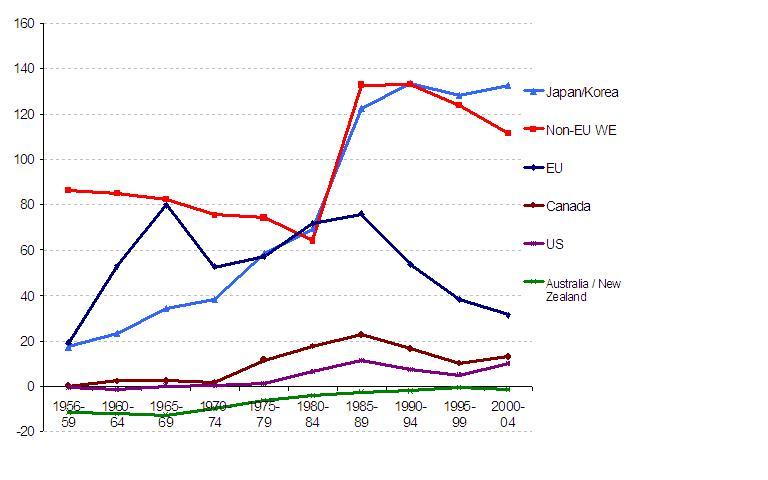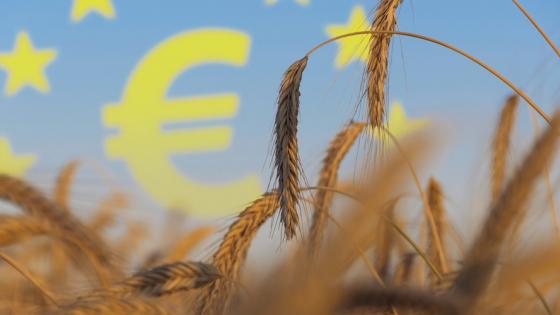The EU’s Common Agricultural Policy (CAP) played an important – if controversial – role in the political integration of Europe fifty years ago.1 At the time of its inception, when Western Europe’s rapid growth favoured industrialisation and urbanisation, many viewed the CAP as the way of extending a hand to the rural community. Moreover, France and Italy were significantly more agrarian than Germany then, so the CAP also played the role of something like a ‘side payment’ in European economic integration.
The CAP worked by sheltering the agricultural sector from external competition with high barriers at the borders and from internal rationalisation by extensive market management. It proved an inflexible instrument for guiding Europe’s agricultural sector into the era of modern farming. Costs of the CAP continued to grow relative to benefits throughout the 1970s and beyond. These costs fell not just on EU consumers, taxpayers and non-agricultural industries but also, through its depressing impact on international food prices, on farmers in many other parts of the world.
The CAP took a major turn in 1992. In that year, EU Agricultural Commissioner Ray MacSharry launched a famous reorganisation programme that subsequent reforms have followed. The basic thrust was to shift support away from the production of food and towards direct payments to farm owners. Fifteen years down the road it is useful to see how much has changed.
The figure shows that the EEC and other Western European countries2 start the period with the highest levels of assistance. They had similar and slightly declining relative rates of assistance (RRAs)3 from the mid-1950s up to the early 1980s, while Japan and Korea converged from below to those rates during that period. By then policies were favouring agriculture over non-agricultural tradable sectors by 60 or more percentage points. Meanwhile, North America and Australasia raised their RRAs over that period, but from a very low base. Indeed the RRA averaged less than zero for Australia and New Zealand, because the rate of manufacturing protection there was well above the agricultural assistance rate. Rates rose in all countries in the 1980s in the wake of the agricultural export subsidy war between the EU and North America (which drove international food prices to their lowest level ever in real terms). Since then, RRAs have come down for the EU as well as for other OECD countries, although least so for Other Western Europe and Japan and Korea which continued their generous support to agriculture when the EU began to rein in its policies. By the turn of the century, the EU was perched between the stratospheric levels of protection of Japan, Korea, Norway and Switzerland and the rather low levels in Canada and the US, while Australia and New Zealand have unilaterally moved to virtually free markets in both farm and non-farm goods.
The rate of assistance granted by the CAP reflects both external developments, principally the level of world prices as modified by exchange rate movements, and internal developments, notably enlargement impacts and policy reforms (often linked to budget pressures). More recently, multilateral constraints such as the commitments made by the EU in the Uruguay Round have had a significant impact. The period of high world prices in the early 1970s shows up as a significant decline in the level of support. But the opportunity to reorient the policy towards world markets was squandered over the next decade, as institutional prices were ratcheted up in an agricultural “scala mobile”. By the mid-1980s, when world prices were low, the CAP had become a major external as well as internal albatross. Price restraints at the end of the 1980s and policy reforms of the 1990s have helped to reverse the trend, and to at least partially reconnect European agriculture to the global market place.
To what extent has the CAP lured new members into its protectionist web? The “enlargement effect” is mixed. In the 1970s, the UK abandoned its somewhat more liberal agricultural policy, and allowed the EU to delay reform by helping to finance the CAP. Ireland and Denmark enjoyed switching from the lower-priced UK market to the more lucrative Continental market for their export products. In the 1980s, Spain received a boost in agricultural support by adopting the CAP, though Portugal had to reduce many of its prices.4 When the Nordic and Alpine countries joined, support levels in those countries generally declined, so the CAP can be credited with some restraint on Austrian and Finnish policy.5 The most recent enlargement has already and will continue to increase both the nominal and the relative rates of assistance in all but the most protective (Slovenia and Romania) of the new EU members.
The 1992 reforms allowed the EU to agree to constraints on spending on export subsidies and on trade-distorting support. The combination of internal policy reform and external commitments under the WTO has changed the trajectory of the CAP. However, the CAP continues to support major unproductive sectors of European agriculture, notably through high levels of border protection. This has helped to frustrate the World Trade Organization’s ongoing Doha Development Agenda and to embarrass the EU’s broader commercial policy agenda.
A key question is whether the path of reform of the EU will continue. It is unfortunate that the opportunity afforded by the Doha Round to eliminate export subsidies and lock in low levels of domestic support (and halve the EU’s external bound tariff on farm goods) seems to be slipping away. If the political attraction of the “new” elements of the CAP, emphasising quality foods and environmental sensitivities, remains strong, then a reversion to the explicit trade-distorting support of the past is unlikely -- although some elements of trade distortion are sure to remain in the form of overly cautious non-tariff barriers ostensibly for food quality and environmental protection.
Relative rate of assistance to agriculture, EEC/European Union and other high-income country groups, excluding decoupled payments, 1956 to 2004 (percent)
Footnotes
1 This column is based on the recent CEPR Policy Insight No. 13
2 The countries in this “non-EU” European aggregate change as the EU enlarged. By the end of the period, only Norway and Switzerland are in that category. Thus changes in the level of protection for this aggregate reflect the change in country composition as well as policy changes. It can be thought of as an average “EFTA” support level.
3 The Relative Rate of Assistance is calculated as RRA = 100[(100+NRAag)/(100+NRAnonag) - 1], where NRAagt and NRAnonagt are the average percentage Nominal Rates of Assistance for the tradable parts of the agricultural and non-agricultural sectors, respectively.
4 Greek membership in 1981 had little impact either on the EU or on Greek agriculture, as its production of the main temperate zone products was small.
5 Sweden had reformed its own policy in 1990 and therefore had to undo those reforms on joining the EU



